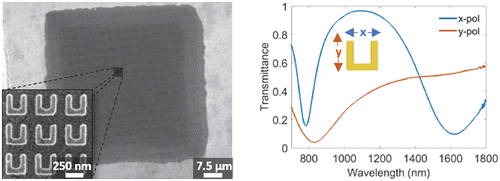当前位置:
X-MOL 学术
›
ACS Photonics
›
论文详情
Our official English website, www.x-mol.net, welcomes your feedback! (Note: you will need to create a separate account there.)
Plasmonic Metasurfaces Situated on Ultrathin Carbon Nanomembranes
ACS Photonics ( IF 7 ) Pub Date : 2020-03-02 , DOI: 10.1021/acsphotonics.0c00073 Y. Denizhan Sirmaci 1, 2 , Zian Tang 3 , Stefan Fasold 1, 2 , Christof Neumann 3 , Thomas Pertsch 1, 2, 4 , Andrey Turchanin 2, 3, 5 , Isabelle Staude 1, 2
ACS Photonics ( IF 7 ) Pub Date : 2020-03-02 , DOI: 10.1021/acsphotonics.0c00073 Y. Denizhan Sirmaci 1, 2 , Zian Tang 3 , Stefan Fasold 1, 2 , Christof Neumann 3 , Thomas Pertsch 1, 2, 4 , Andrey Turchanin 2, 3, 5 , Isabelle Staude 1, 2
Affiliation

|
During the past decade, optical metasurfaces consisting of designed nanoresonators arranged in a planar fashion were successfully demonstrated to allow for the realization of a large variety of flat optical components. However, in common implementations of metasurfaces and metasurface-based devices, their flat nature is thwarted by the presence of a substrate of macroscopic thickness, which is needed to mechanically support the individual nanoresonators. Here, we demonstrate that carbon nanomembranes (CNMs) having nanoscale thicknesses can be used as a basis for arranging an array of plasmonic nanoresonators into a metamembrane, allowing for the realization of genuinely flat optical devices. CNMs belong to the family of two-dimensional materials, and their thicknesses and mechanical, chemical, and electrical properties can be tailored by the choice of the molecular precursors used for their fabrication. We experimentally fabricate gold split-ring-resonator (SRR) metasurfaces on top of a free-standing CNM, which has a thickness of only about 1 nm and shows a negligible interaction with the incident light field. For optical characterization of the fabricated SRR CNM metasurfaces, we perform linear-optical transmittance spectroscopy, revealing the typical resonance structure of an SRR metasurface. Furthermore, numerical calculations assuming free-standing SRR arrays are in good overall agreement with corresponding experimental transmittance spectra. We believe that our scheme offers a versatile solution for the realization of ultrathin, ultra lightweight metadevices, and may initiate various future research directions and applications including complex sensor technologies, conformal coating of complex topographies with functional metasurfaces, fast prototyping of multilayer metasurfaces, and studying the optical properties of effectively free-standing nanoparticles without the need for levitation schemes.
中文翻译:

位于超薄碳纳米膜上的等离子超表面。
在过去的十年中,成功地证明了由以平面方式排列的设计的纳米谐振器组成的光学超表面可以实现多种平面光学组件。但是,在超颖表面和基于超颖表面的设备的常见实现中,它们的平坦特性因存在宏观厚度的基板而受阻,这是机械支撑单个纳米谐振器所必需的。在这里,我们证明具有纳米级厚度的碳纳米膜(CNMs)可以用作将等离激元纳米谐振器阵列排列到中膜的基础,从而可以实现真正平坦的光学器件。CNM属于二维材料家族,其厚度以及机械,化学,可以通过选择用于制造的分子前体来定制其电学性质和电特性。我们在独立的CNM上实验性地制作了金开口环-谐振器(SRR)超表面,其厚度只有大约1 nm,并且与入射光场的相互作用可忽略不计。为了对所制造的SRR CNM超表面进行光学表征,我们进行了线性光学透射光谱分析,揭示了SRR超表面的典型共振结构。此外,假设独立式SRR阵列的数值计算与相应的实验透射光谱具有良好的总体一致性。我们相信,我们的方案为实现超薄,超轻型元设备,
更新日期:2020-04-23
中文翻译:

位于超薄碳纳米膜上的等离子超表面。
在过去的十年中,成功地证明了由以平面方式排列的设计的纳米谐振器组成的光学超表面可以实现多种平面光学组件。但是,在超颖表面和基于超颖表面的设备的常见实现中,它们的平坦特性因存在宏观厚度的基板而受阻,这是机械支撑单个纳米谐振器所必需的。在这里,我们证明具有纳米级厚度的碳纳米膜(CNMs)可以用作将等离激元纳米谐振器阵列排列到中膜的基础,从而可以实现真正平坦的光学器件。CNM属于二维材料家族,其厚度以及机械,化学,可以通过选择用于制造的分子前体来定制其电学性质和电特性。我们在独立的CNM上实验性地制作了金开口环-谐振器(SRR)超表面,其厚度只有大约1 nm,并且与入射光场的相互作用可忽略不计。为了对所制造的SRR CNM超表面进行光学表征,我们进行了线性光学透射光谱分析,揭示了SRR超表面的典型共振结构。此外,假设独立式SRR阵列的数值计算与相应的实验透射光谱具有良好的总体一致性。我们相信,我们的方案为实现超薄,超轻型元设备,



























 京公网安备 11010802027423号
京公网安备 11010802027423号